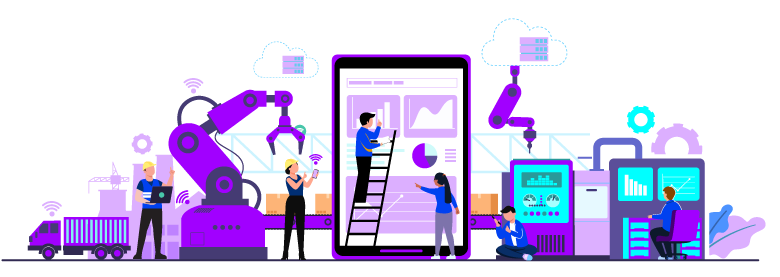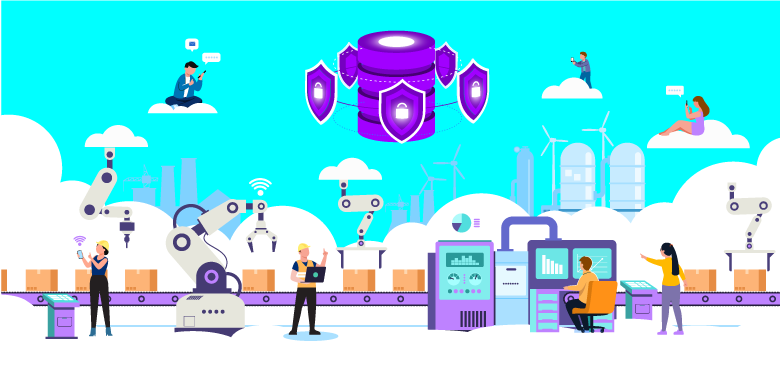
The artificial intelligence revolution is not coming, it is already here and requires companies to rethink their business processes in order to maximize the power of artificial intelligence (AI) to expand human capabilities.
So, everyone who is interested in modern technologies is hearing digitalization, big data and the penetration of artificial intelligence into different areas of our life and work. It's no secret that the life of AI has slowly emerged around us: in our pockets, bags, cars and homes, where our gadgets and various electronic assistants "live". According to leading experts in the field of artificial intelligence, these technologies are now experiencing a third wave, they have finally escaped from research laboratories and are quickly becoming "a key element of business transformation" [1].
In my publication, I would like to share the experience gained in industrializing an AI-based project and formulate five, in my opinion, essential, vital conditions for its successful implementation.
1. One team with a common mindset

At the first stages of the project, when research work takes place, the study of available data, familiarity with the technological process, generation of ideas and hypotheses, business representatives and developers should become a single team with a common understanding of the goals and tasks to be solved. It is important at the first stages of the project that it becomes its own for the united team, so that each of its participants is fully aware and shares responsibility for their actions and the overall result.
As the practice of implementing projects in the metallurgical industry shows, the most productive are teams that include specialists from related divisions of the enterprise: production workers, technologists, economists, IT and data specialists. It is absolutely certain that the development of a project is impossible without employees who will directly use the digital service: they should subsequently become “product owners”.
Otherwise, it turns out that enterprise managers and technologists, whose direct responsibility is to improve the efficiency of production processes, consider the introduction of digital services as a means to achieve their goals and are highly motivated in such initiatives. And the exploitation side, people who directly work in production with their own hands, treat this as the imposition of additional controls or additional complication of the already familiar and well-established production processes. Or, for example, the development team, the operation side and the technologists jointly developed a set of hypotheses and even conducted experiments that confirmed their reliability, but it may turn out that their technical implementation is impossible due to the lack of the necessary data or signal sources.
This is how they describe their approach to the implementation of digital solutions at one of the largest industrial enterprises in Russia. The work of the teams began with the fact that the production workers were asked to identify their problems and wishes: who has what "hurts", who needs what for their own plans. All employees have goals that are linked to our strategy. For example, we understand how a specific rolling mill should operate in five years, what should be the quality of products, consumption of raw materials, downtime, etc., in order for the strategy in this area to be implemented. And each team that works with a specific unit knows what results it should achieve. Of course, achieving these targets is not easy, or all companies would be equally effective and profitable. Therefore, the production staff readily responds,if he is offered help in solving specific problems.
Teams discuss in which problematic or high-potential areas digital tools can help, formulate hypotheses on how this can be done.
2. Transition to a new culture of technological and business processes

In the course of a number of studies in recent years, scientists have found that “when making the same error in predictions, people are more likely to stop trusting an algorithm than a person” [1].
Yes, people tend to trust their own kind more, because they know how we work, because they roughly understand the logic of each other's behavior and can easily imagine themselves in the place of another person, project the situation.
When first line and middle managers were asked what would motivate them to trust the advice of the system, 60 percent chose the option “A clear understanding of how the system works and how it generates advice”, 55 percent - “System with a proven track record”, and 49 - “ A system that explains its logic ”[2].
Companies that are taking a course towards digitalization and moving to a new level of building technological and business processes through the introduction of AI systems have a difficult leadership task to form a corporate culture that contributes to understanding the goals, stages, methods of their design and implementation. This goal is not easy to achieve, as many people, especially those who will have to interact directly with AI, are often worried that machines may eventually take their place, and they will be unnecessary without their own craft.
In the working environment, it is necessary to form an understanding that artificial intelligence will allow not to be distracted by individual tasks and is aimed not at replacing employees, but at expanding their capabilities, transferring functionality to a new level, facilitating their work and the ability to focus not on routine procedures, but on things. really needing human intelligence.
The development team, for its part, must master the language of the industry, immerse itself as deeply as possible into production and technological processes.
It is extremely important that people who will directly use AI understand the basic principles of its structure and behavior, can make adjustments to the results of its work and feel like active participants in the development, so that they have a sense of transparency and control of the system. Ideally, of course, AI systems should be designed so that they explain their decisions and help people maintain some autonomy in making decisions.
3. Experimenting with AI

Several times in our practice, it happened that the production teams that worked with our service did not follow its recommendations or tried to "cheat" him because they were afraid to receive a scolding from their bosses for a possible decrease in production efficiency indicators and increased production costs (for example, increased power consumption).
At the stages of hot testing of the AI system, it is important to create the most trusting environment within the united team, it is important to make it clear to the experimenters that a negative result is also a result and sometimes it is even more valuable than a positive one. Here you need to be as honest as possible and not hide the true state of affairs. Somewhere this is comparable to an appointment with a doctor. The patient does not always have a desire to talk about all his symptoms and health abnormalities, he hides some, and subsequently the treatment becomes much longer, more expensive and complicated.
The trick is becoming a “little bit of a startup” and learning how to quickly experiment with startup-style digitalization. Their usual rule is: "If it works, we go ahead, if not, try a new idea." Each such startup is a multi-stage process of working out and developing a hypothesis from birth, through verification and transformation into a working solution, until a business effect is obtained. Moreover, employees who are engaged in one hypothesis must accompany it from beginning to end [2].
The main metric for the development of the hypothesis should be the business effect, for which it is important to build a calculation model at the very beginning of the project, while at each step this model is updated. Initially obvious sources of effect for a hypothesis may turn out to be unpromising, but in the course of implementation, new ideas may appear, and the result will be achieved due to them.
4. The importance of a streamlined and complete data delivery

First of all, it should be noted that data quality plays a critical role in artificial intelligence systems. Essentially, data is the fuel for artificial intelligence. Most of the time and effort is spent on collecting and studying an adequate data set for the formation and testing of hypotheses. Experience says that about 80 percent of the time it takes to implement AI initiatives is data extraction, delivery and preprocessing, feature construction, and not the compilation of the algorithms themselves. It is necessary to explain to the business customer how important it is to assemble a high-quality dataset and why it takes so much time to create it.
In our experience, at the initial stages of the project there will be no data at all or their volume will be limited both in terms of storage depth and discreteness, they will have a large number of gaps and an overall low level of quality. And you will have to work with this: figure out how to build models operating with incomplete data, how to optimally interpret low-quality ones.
In our practice, there were also cases when technologists or production workers convinced us of the uselessness of a whole series of technological data, which, in their opinion and experience, can in no way influence the formation of an assessment or recommendation of an AI system. However, in practice, it turned out that it was these, at first glance, non-target data that helped AI to capture the most subtle dependence of the technological process, and the predictive power of the model increased precisely due to them.
Therefore, it is important from the very beginning of the project to prepare a full-fledged platform for the smooth and uninterrupted delivery of data, they should be extensive, diverse, of high quality and useful. Instead of building chains for the delivery of individual data to test a specific hypothesis, but establishing a process that will help you quickly configure the required dataset and have sufficient potential to increase the amount of information delivered.
5. Long distance race

For Russian companies, the concept of digital transformation is associated with the introduction of machine learning, big data analytics, artificial intelligence, robotization, and augmented reality. According to experts, the greatest success in this direction is achieved by those companies that consider it not as a set of separate initiatives, but as a comprehensive digitalization program that affects a whole range of interrelated processes and changes in the company.
AI projects, like any innovation, should be viewed as a venture business. Not all projects will pay off, even less will bring tangible benefits, but several projects will bring returns that will cover all costs many times over.
As a consequence, it is imperative to avoid early screening of seemingly utopian concepts. The flight of a man into space also looked like a classical utopia for quite a long time, it was rejected as impossible at the level of science.
Conclusion
Today, artificial intelligence is rapidly penetrating most areas of industry and business. The new reality of human-machine interaction requires a rethinking of previously established technological and business processes. The digital explosion has already occurred and the digital universe is expanding now. Those who can understand the physical laws of the new world, follow the periphery of the current digital front, will not be afraid to experiment and introduce new technologies, and will move to a new qualitative level of efficiency of business processes in their field of activity.
Literature
- +. / , ; . . , ; [. . . , . , . , . ]. – .: , , 2019. – 304 .
- .0. / : . . – .: «», 2019.-320 .